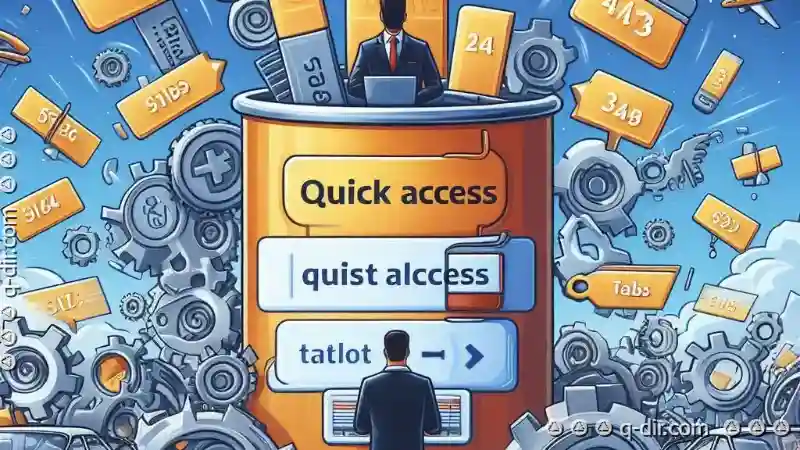One such technology is the tab interface - ubiquitous in applications from smartphones to tablets and desktop computers. Despite its widespread use, ...
 critics argue that the concept of "quick access" or frequently used items on tabs has seen limited innovation, leading to a stagnation in this aspect of navigation design. This blog post explores the implications of this stagnant progress and what it means for both users and developers. In today's fast-paced digital world, navigation and display technologies play a crucial role in enhancing user experiences across various devices.
critics argue that the concept of "quick access" or frequently used items on tabs has seen limited innovation, leading to a stagnation in this aspect of navigation design. This blog post explores the implications of this stagnant progress and what it means for both users and developers. In today's fast-paced digital world, navigation and display technologies play a crucial role in enhancing user experiences across various devices.1. The Evolution of Tabs: Past vs. Present
2. The Criticism: Tabs Have Become "Quick Access" Buttons Without Functionality Growth
3. Potential Consequences of Stagnant Progress
4. Possible Solutions and Innovations
5. Conclusion: Embracing Change for Better User Experiences
1.) The Evolution of Tabs: Past vs. Present
Historical Perspective
Initially introduced in the early days of graphical user interfaces (GUIs), tabs were designed to help users manage multiple documents or applications more efficiently by allowing them to switch between different content sets without closing each one individually. The concept remained relatively unchanged for years, focusing mainly on organization and accessibility within a single window.
Modern Implementation
With the advent of mobile devices and multi-tasking operating systems, tabs have evolved into an integral part of navigation interfaces, facilitating quick access to various features or content areas through horizontal bars at the top (or bottom) of a screen. Features such as drag-and-drop organization, customizable order, and pinned tabs were introduced over time to enhance usability but often lacked significant changes in core functionality.
2.) The Criticism: Tabs Have Become "Quick Access" Buttons Without Functionality Growth
Functional Limitations
Many users feel that while the number of tabs can grow quite large, their usefulness does not proportionally increase due to limited interactivity or customization options. For example, a user might have several pinned tabs on their browser for quick access but rarely switches beyond these specific favorites unless forced by necessity (e.g., multiple windows open).
Cognitive Overhead
The more tabs one has pinned, the greater the cognitive overhead in distinguishing between them and remembering what each tab represents or contains. This can be particularly cumbersome when many tabs are related to different projects or tasks but share similar names or domains.
3.) Potential Consequences of Stagnant Progress
User Dissatisfaction
As stagnation breeds complacency, users may become frustrated with the lack of innovation in tab management tools and might consider switching to alternative platforms that offer more dynamic navigation solutions. This could lead to a loss in user engagement and loyalty to specific apps or systems.
Limited Innovation in Interface Design
The failure to innovate on existing features can stunt creativity in interface design generally, as designers are often constrained by the need for simplicity and usability rather than pushing boundaries with complex interactions that might be deemed unnecessary or confusing.
4.) Possible Solutions and Innovations
Personalization and Contextual Awareness
One approach could involve using machine learning algorithms to analyze user behavior and context (such as time of day, location, or previous actions) to dynamically adjust which tabs are displayed at any given moment based on predicted usefulness. This would reduce cognitive overload by only displaying relevant tabs and apps that the user is likely to need right now.
Progressive Disclosure Interfaces
Implementing interfaces where more options become visible when interacting with a tab, such as revealing additional settings or content areas through taps or swipes, could provide users with greater control over their navigation experience without cluttering every tapable area with too many options.
5.) Conclusion: Embracing Change for Better User Experiences
While the tab interface has proven its utility in simplifying access to various applications and information, there is a clear need for innovation that can enhance usability without compromising on simplicity. By embracing personalized experiences, contextual awareness, and more interactive interfaces, developers and designers can not only improve user satisfaction but also spark new ideas in navigation design that could benefit other areas of digital interface development.
In conclusion, stagnation in the "quick access" functionality of tabs may lead to diminishing returns for users and stifled innovation for developers. By embracing change through personalized experiences and progressive interfaces, we can ensure that tab-based navigation remains a robust and engaging tool for managing modern applications and information.

The Autor: / 0 2025-03-03
Read also!
Page-

The Tree View Illusion: Order Where Chaos Truly Reigns.
One particularly intriguing aspect of these two elements is the phenomenon known as the "Tree View Illusion. " This illusion highlights how seemingly ...read more

How to Create Slideshows in Preview Pane
Apple's macOS has undergone significant upgrades, making it one of the most user-friendly operating systems available. One such upgrade is the ...read more

Why Favorites Are Useless Without Sync
Navigation and display systems have become an integral part of modern vehicles, providing convenience and safety while navigating through unfamiliar ...read more